This post may contain affiliate links.Please read our disclosure policy.
Pfannkuchen (German Pancakes) are so easy to make and a perfect cross between American pancakes and French Crepes. A classic German recipe made with simple ingredients that can be served sweet or savory.
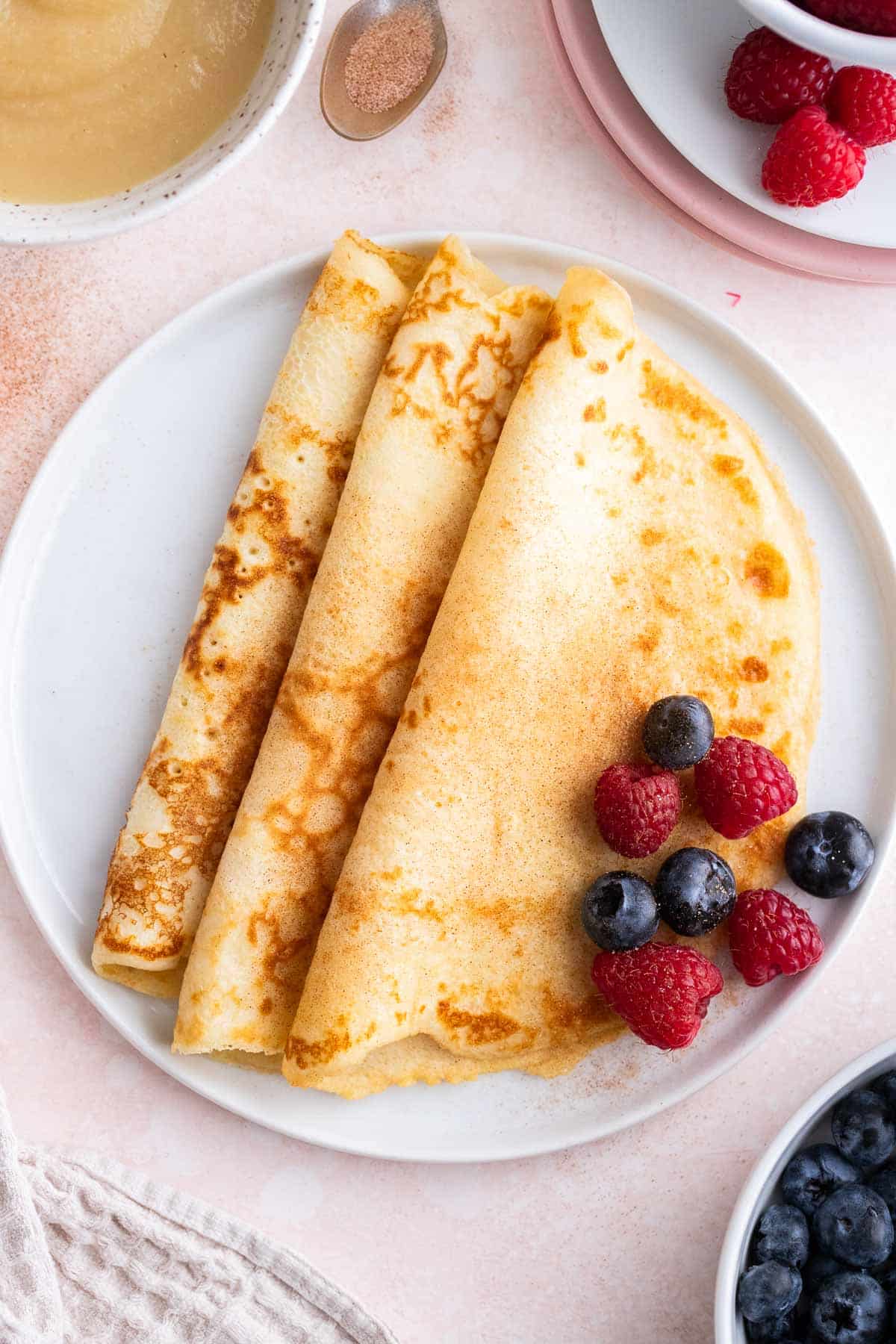
Growing up one of my favorite things to eat at my Oma’s house was Pfannkuchen. We usually ate them for lunch or dinner sprinkled with cinnamon sugar and topped with apple sauce or Nutella. Today my family still enjoys making this easy German dish following her recipe.
Traditional German pancakes are bigger and thinner than American pancakes and not fluffy. You could describe them as a thicker French crepe and they are perfect for filling them and rolling them up. They are also sometimes called Eierkuchen (egg cakes) or Palatschinken (Austria and Eastern Europe).
Pfannkuchen are made without baking powder (or baking soda). My grandmother also never used whipped egg whites and there is also no sugar added to the batter. This way they can be enjoyed sweet and savory.
Table of Contents
Why you’ll love this recipe
- Authentic German recipe: My pancakes taste exactly the same as the Pfannkuchen I grew up with.
- Super simple to make: One bowl is all you need. The batter can be made in 1 minute. This is a really uncomplicated recipe, my grandmother usually didn’t even measure anything.
- Simple ingredients: You definitely have all the ingredients in your pantry.
- Kids and adults love this recipe: Everyone can add their favorite topping or filling.
Ingredient notes
Here is an overview of the ingredients you’ll need for this recipe. Scroll down to the recipe card at the bottom for quantities.
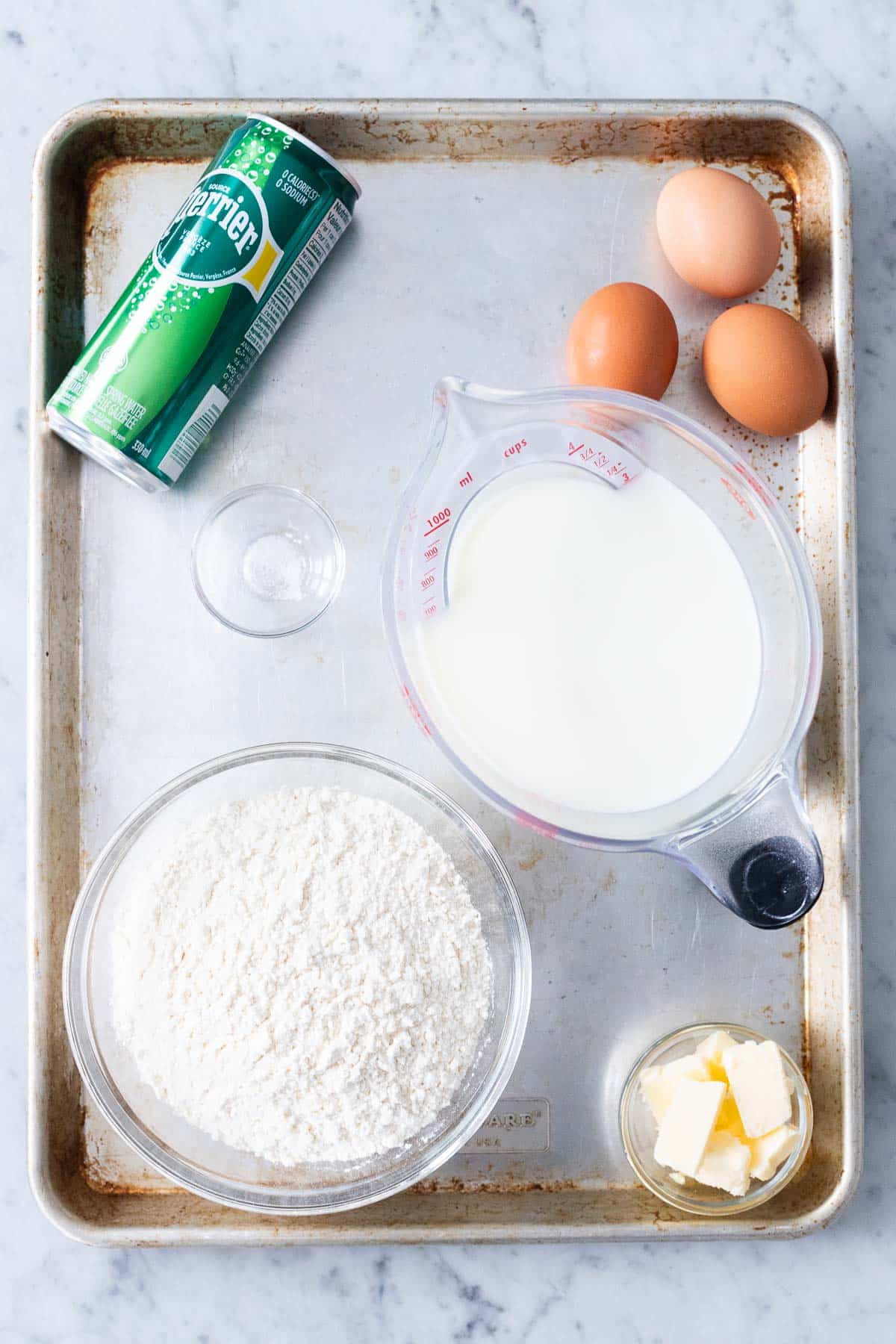
- Flour – This recipe uses all-purpose flour but you can also replace parts of the flour with whole wheat flour.
- Milk – I use whole milk but 2% milk works too.
- Eggs – You need three large eggs for this recipe.
- Sparkling water – Adding some sparkling water is optional but popular in Germany to add some rise to the pancakes. Don’t replace it with baking powder.
- Butter – Unsalted butter or Butterschmalz (clarified butter) are used to cook pancakes. It adds flavor and gives them the typical Pfannkuchen taste. You could also use a neutral oil like avocado oil.
How to make this recipe
Detailed measurements and instructions can be found at the bottom of the page on the printable recipe card.

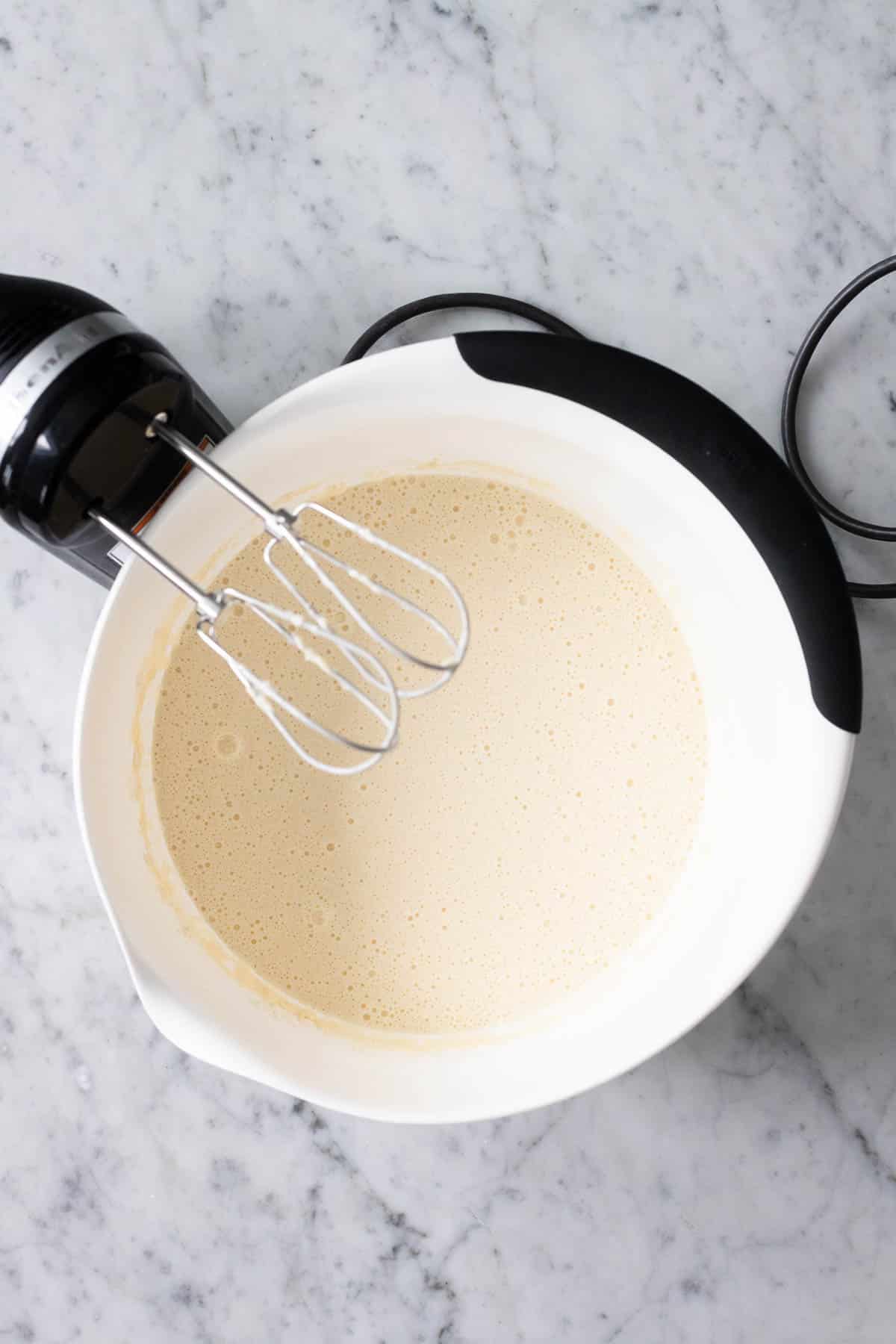
- Combine: Combine all the ingredients for the batter in a large mixing bowl. I like to use my hand mixer or a whisk but you could also use a stand mixer.
- Mix: Whisk the batter until bubbles start to form, about 1-2 minutes. You don’t want any remaining lumps.
- Rest: Cover the bowl and put it in the fridge for about 30 minutes. This step is optional but I recommend doing it because it gives the pancakes a better texture. 10 or 20 minutes would also be fine if you’re short on time.
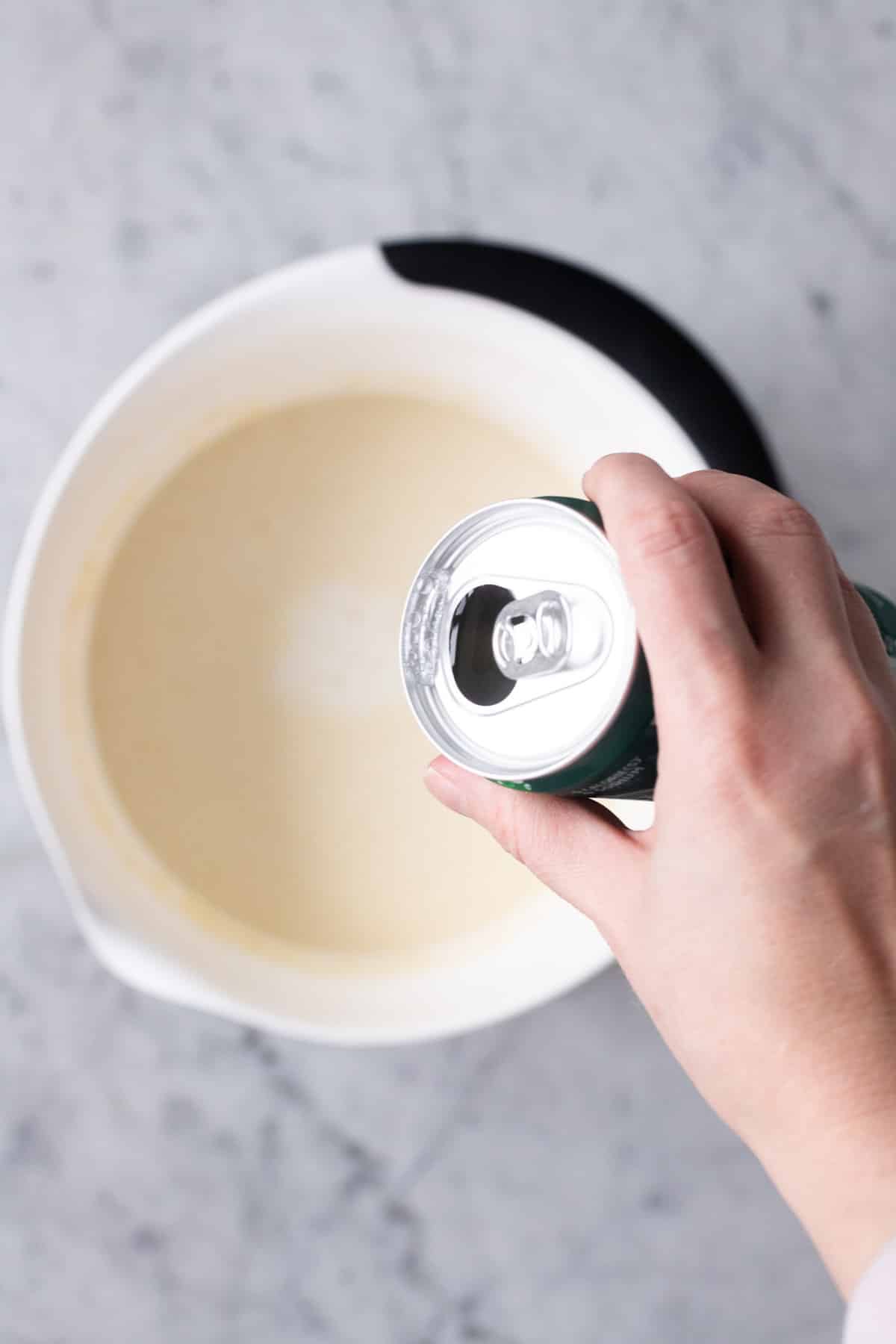
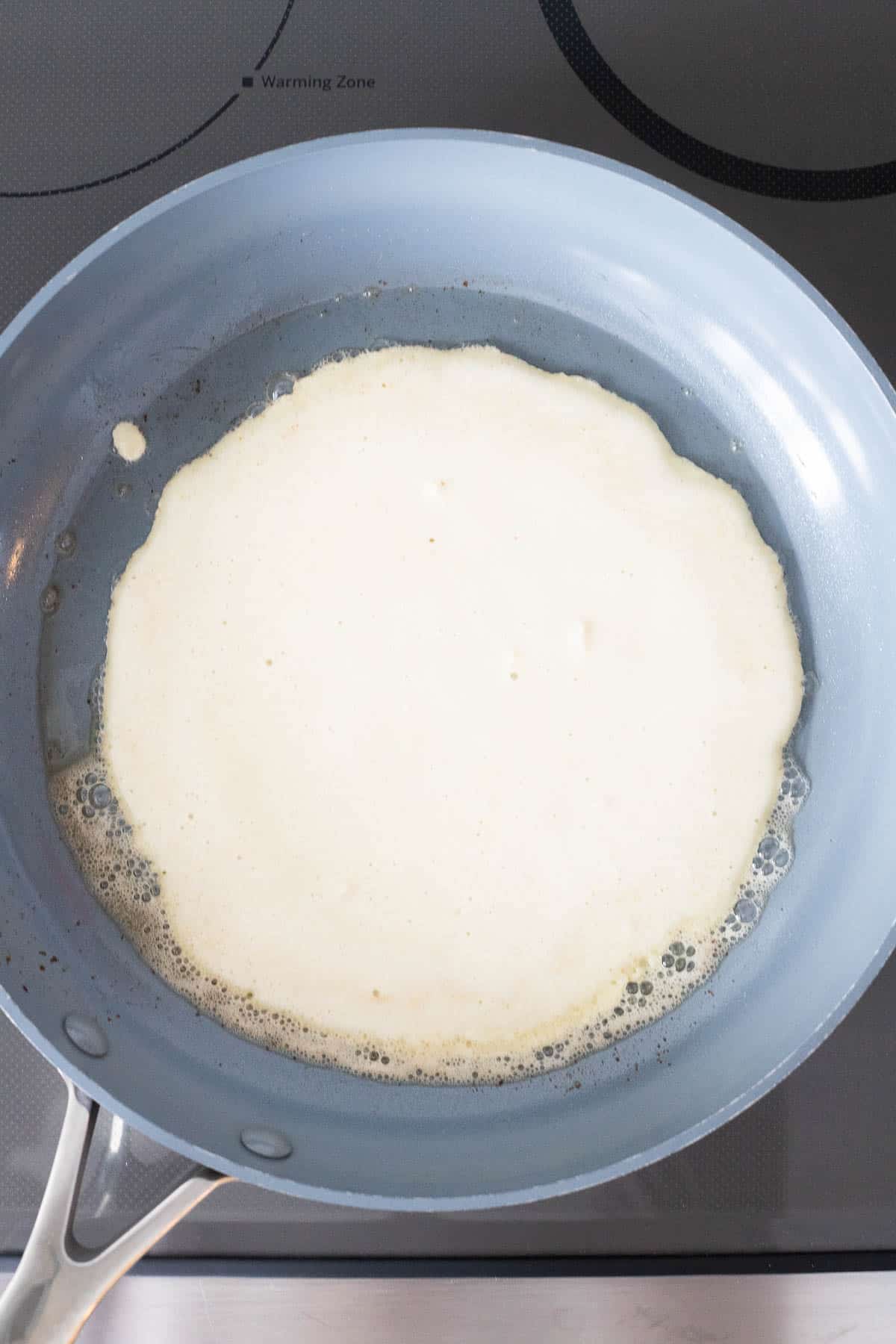
- Add sparkling water: Take the batter from the fridge, add the sparkling water, and stir it. Adding some sparkling water adds a hint of fluffiness. If you don’t have any, skip this step.
- Fry pancakes: Heat a large enough pan over medium heat and add about 1 tsp of butter when it is heated up. When the butter has melted, add 1/2 cup of batter in the middle of the pan and tilt the pan so it spreads out evenly. The first pancake will always be kind of ugly, that’s normal.
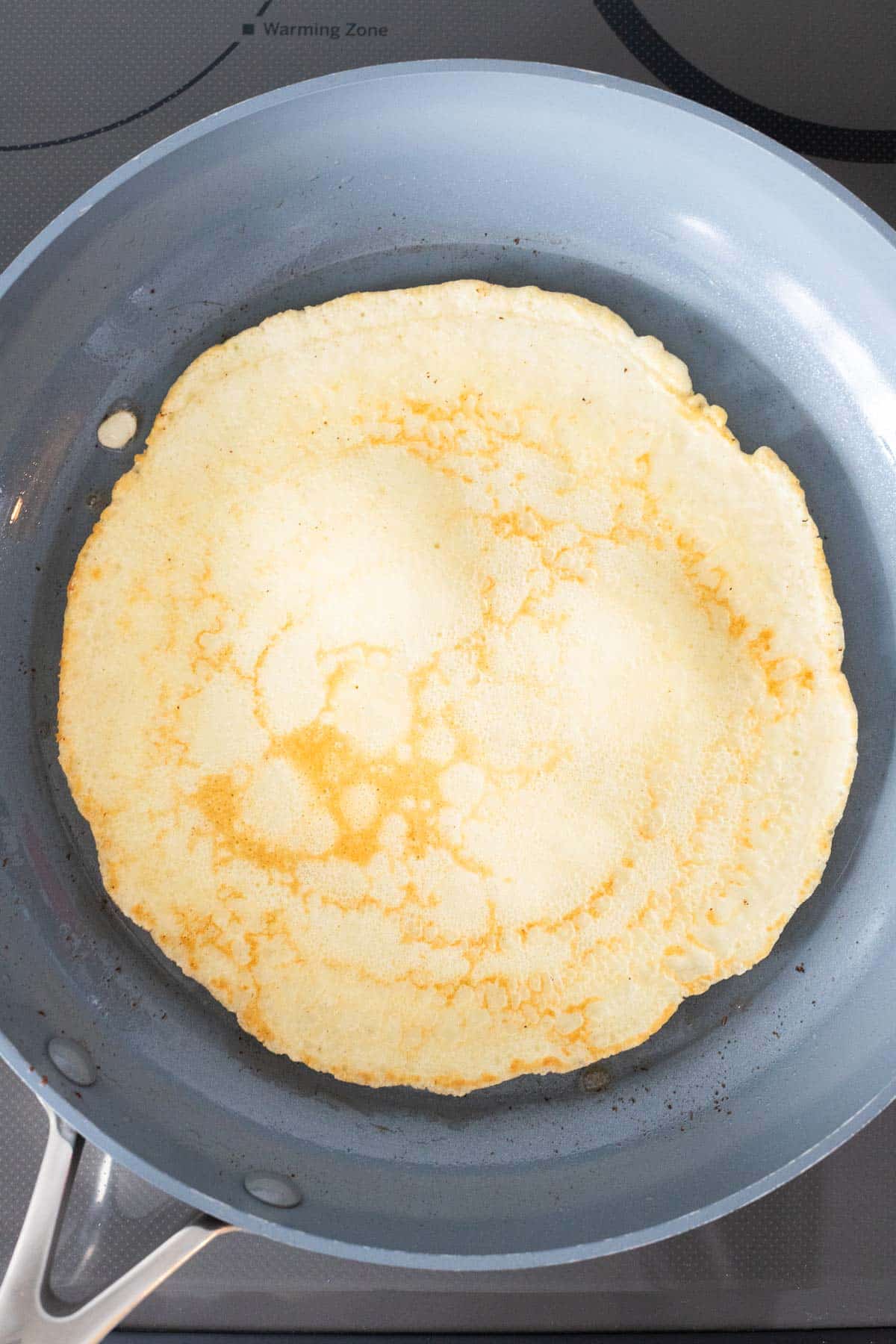
- Flip pancakes: When the top of the pancake starts to bubble and the edges are getting crispy it’s time to flip it carefully. Cook it for another minute or so then transfer it to a plate and keep it warm.
- Repeat: Add butter to the pan and continue making pancakes until all the batter is used.
Did you know?
In some German regions, such as Berlin, Pfannkuchen are actually a type of filled pastry similar to a jelly doughnut. This pastry is called Berliner or Krapfen in most German regions. If you’re looking for a recipe, check out my Krapfen Recipe.
Expert tips for success
- Keep warm: To keep the pancakes warm while making them put a plate in the oven set to warming or at low heat, about 140 degrees F.
- Sparkling water: Adding sparkling water (Mineralwasser in German) to the batter just before cooking is a popular way in Germany to add a little bit of rise to the pancakes. But it’s optional. Don’t replace it with baking powder or whipped egg whites.
- Size: Pfannkuchen are larger than American pancakes, they should fill out the whole pan.
- Pan: I use a ceramic pan so the pancakes don’t stick and usually fry two pancakes simultaneously in two pans.
- Flipping: This can get tricky, I recommend using a large turner and waiting until the underside is completely done and the top looks nearly set before attempting to turn the pancakes.
- Chilling: I recommend refrigerating the batter after making it, so the flour can hydrate and the batter thickens slightly. However I often cut this step short depending on my time, and the difference is not too noticeable.
- Sticking: If the pancakes stick to the pan, use more butter or turn down the heat a little.
- Flädlesuppe: This is a popular German dish for using leftover pancakes. It’s a simple soup made from clear broth and thinly cut strips of Pfannkuchen. Just heat some broth and add pancakes.
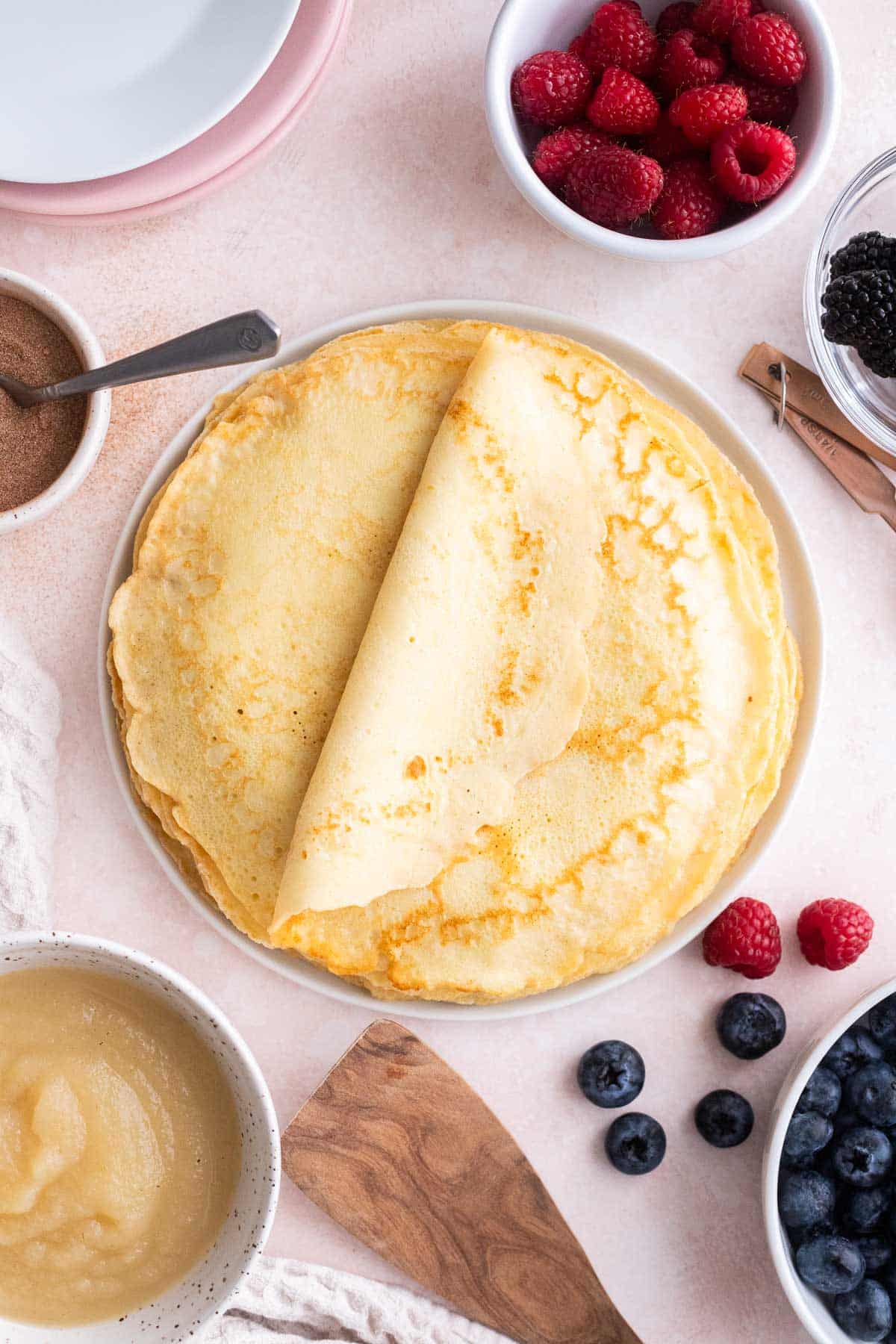
Recipe FAQs
The batter for a Dutch baby is very similar to German pancakes but a Dutch baby is served as a large, puffy pancake made in the oven that’s shared, while German pancakes (or Pfannkuchen) are individually sized, pan-fried, and can be sweet or savory. Despite its name, the Dutch baby is not from the Netherlands but is an American creation with German roots, inspired by the German Pfannkuchen. That’s why Dutch babies are also sometimes called German Pancakes.
American pancakes are thicker, fluffier, and smaller. They are served with syrup.
Pfannkuchen are thinner, larger, and not as fluffy. They can be served as is with fruit or apple sauce on the side or rolled with different sweet and savory toppings.
French Crepes are even thinner and larger, and get crispy on the edges. They are usually served folded and filled with Nutella, ham and cheese, or other fillings.
Serve sweet or savory
Because traditional German pancakes don’t contain any sugar you can serve them sweet or savory. Growing up we ate Pfannkuchen usually with apple sauce on the side and often sprinkled with cinnamon sugar.
But they can also be filled with sweet and savory fillings. Usually, the filling is put on the cooked pancake and then the pancake gets rolled up and served. Make sure the filling isn’t too liquid otherwise the pancake gets soggy. Here are a few ideas:
Savory fillings
- Creme cheese and smoked salmon: A thin layer of cream cheese topped with smoked salmon and a little bit of dill
- White asparagus, ham, and sauce hollandaise: This is a very popular way to eat white asparagus when it is in season
- Sauteed mushrooms
- Ham and cheese
- Sauteed vegetables
Sweet fillings
- Nutella
- Apple sauce: My family loves eating pancakes with unsweetened apple sauce
- Jam
- Fruit compote
- Lemon curd
- Cinnamon and sugar: To make this popular topping combine 10 tablespoons of granulated sugar with 1 tablespoon of cinnamon
- Lemon juice and cinnamon sugar: Squeeze a bit of lemon over the pancake then sprinkle with cinnamon sugar
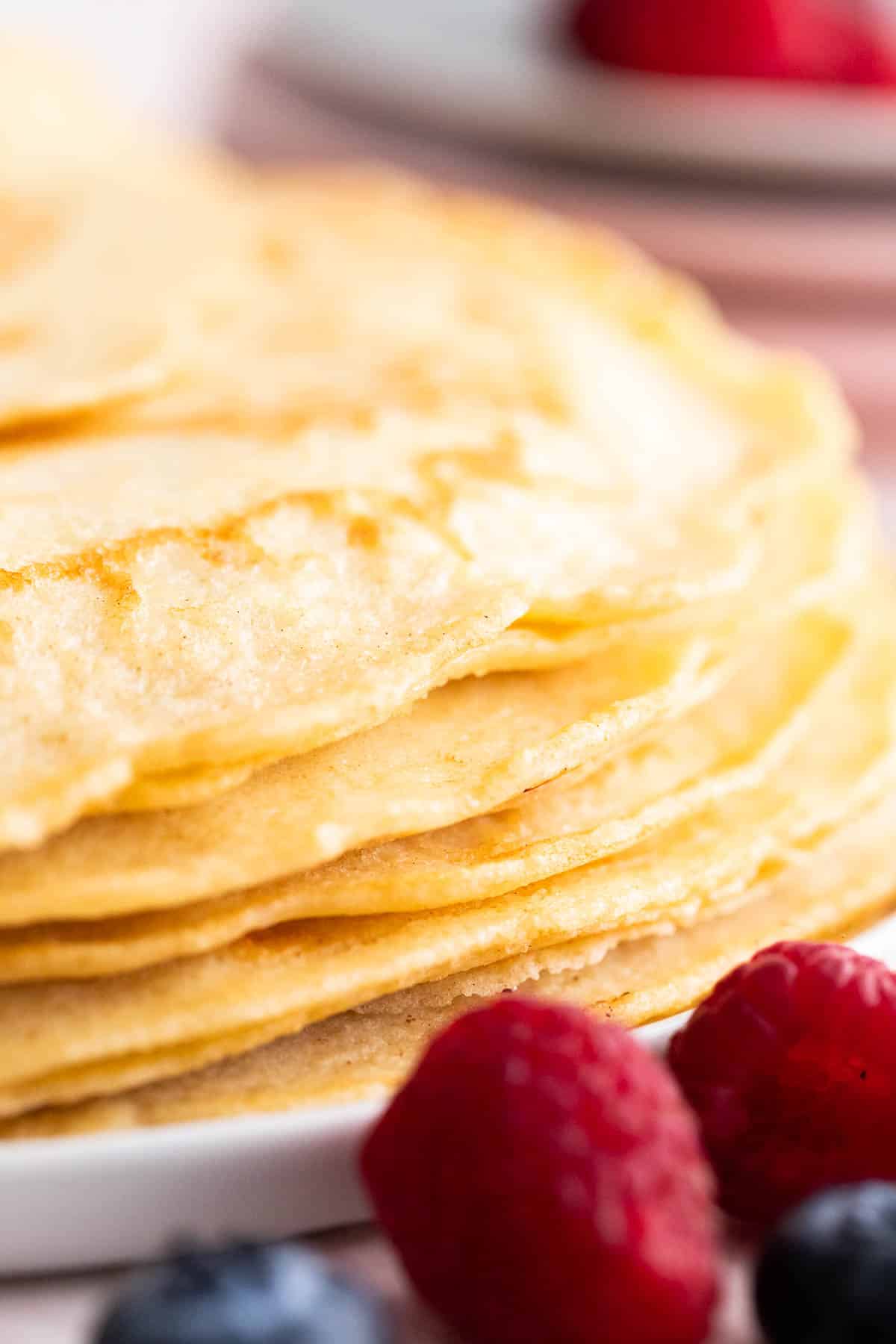
Leftovers
Leftover German pancakes can be stored in the fridge for 2-3 days. You can reheat them in a pan or microwave, or eat them cold. We love to use leftovers for Pfannkuchensuppe (pancake soup) the next day or pack them rolled up for lunches often with a fun filling like Nutella or ham.
The batter also keeps well overnight in an airtight container in the fridge. Because of the fresh eggs, I recommend using it within 24 hours.
Freezing
Pfannkuchen can be frozen with parchment paper in between so they don’t stick and you can easily take out single portions. Put the cooled pancakes in an airtight container or freezer bag. Defrost them overnight in the fridge and reheat them in a pan over medium heat or in the microwave.

Pfannkuchen Variation
A popular variation of Pfannkuchen in Germany is Apfelpfannkuchen (apple pancakes). You can easily use this pancake recipe as a base to make this variation. Peel, core, and finely slice two or three apples. Add them to the batter with the sparkling water and make the pancakes according to the recipe below.
More Recipes to Try
German Recipes
Kaiserschmarrn
German Recipes
German Potato Salad
Cakes
Apple Strudel Recipe
Sides & Salads
Easy German Spaetzle Recipe
Never Miss A Recipe! Subscribe to my newsletter and follow along on Facebook, Instagram, and Pinterest for more great recipes and all of the latest updates.
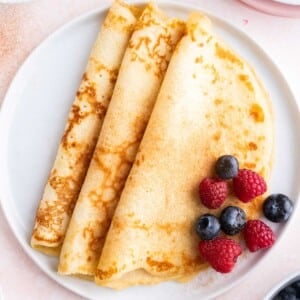
Pfannkuchen (German Pancakes)
Ingredients
- 3 cups all-purpose flour
- 3 cups milk
- 1 pinch salt
- 3 large eggs
- 2 Tbsp sparkling water, optional
- unsalted butter, for frying
Instructions
- In the bowl of a stand mixer fitted with the paddle attachment or using a hand mixer, combine flour, milk, salt, and eggs. Beat until bubbles develop, about 1-2 minutes. For the best results, put the batter in the fridge for 30 minutes.
- Take the batter out of the fridge, add sparkling water, and give it a stir.
- Heat a large pan (or two) over medium-high heat, then add some butter to the pan.
- Transfer about ½ cup of the batter to the hot pan and tilt the pan so it spreads out evenly.
- Cook until bubbles form on top and the edges are crisping up, about 2 to 3 minutes. Then flip the pancake and cook until golden brown on the other side. Repeat with the remaining batter.
Notes
- Keep warm: To keep the pancakes warm while making them put a plate in the oven set to warming or at low heat, about 140 degrees F.
- Sparkling water: Adding sparkling water (Mineralwasser in German) to the batter just before cooking is a popular way in Germany to add a little bit of rise to the pancakes. But it’s optional. Don’t replace it with baking powder or whipped egg whites.
- Size: Pfannkuchen are larger than American pancakes, they should fill out the whole pan.
- Pan: I use a ceramic pan so the pancakes don’t stick and usually fry two pancakes simultaneously in two pans.
- Flipping: This can get tricky, I recommend using a large turner and waiting until the underside is completely done before attempting to turn the pancakes.
- Chilling: It is recommended to chill the batter after making it so the flour can hydrate and the batter thickens slightly. However I often skip this step depending on my time, and the difference is not too noticeable.
- Sticking: If the pancakes stick to the pan, use more butter or turn down the heat a little.
- Flädlesuppe: This is a popular German dish for using leftover pancakes. It’s a simple soup made from clear broth and thinly cut strips of Pfannkuchen. Just heat some broth and add pancakes.
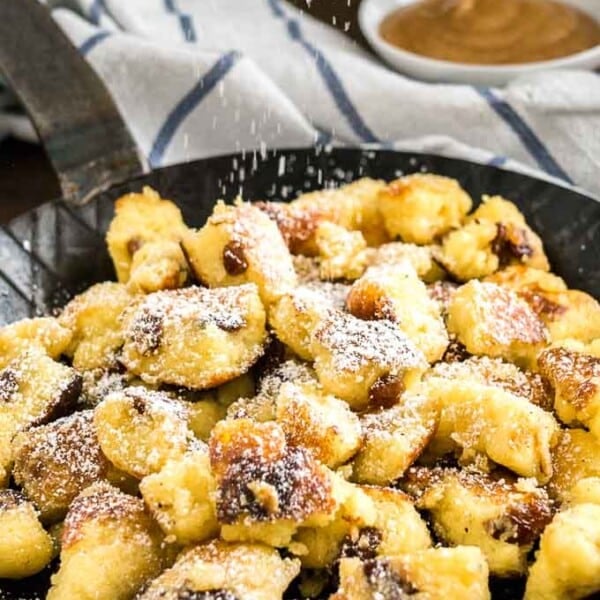
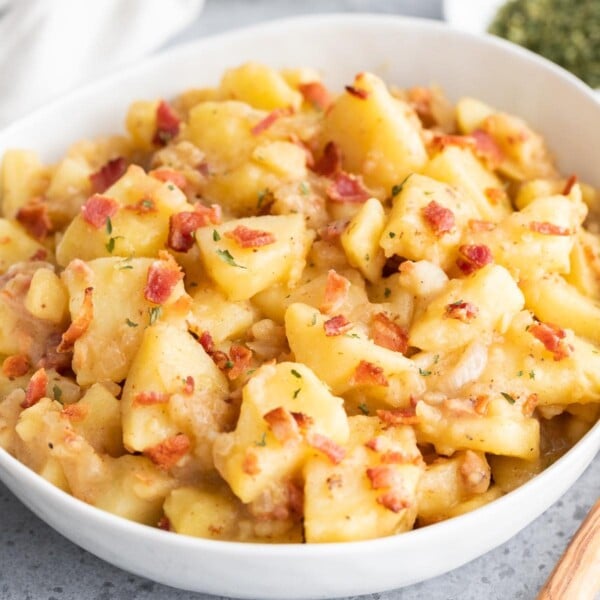
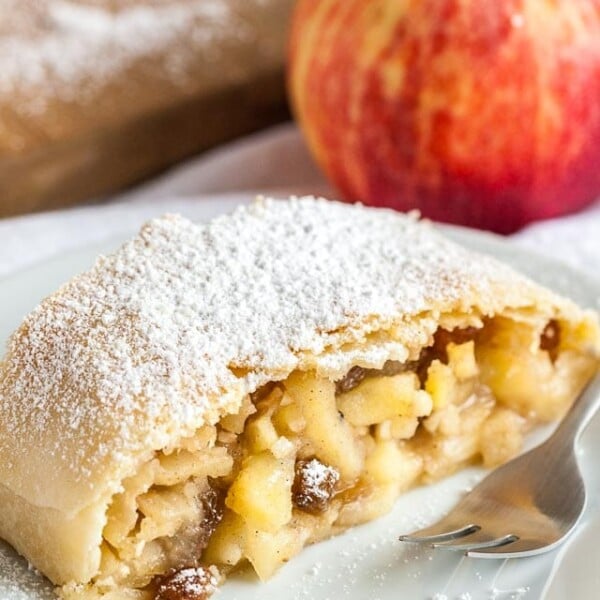
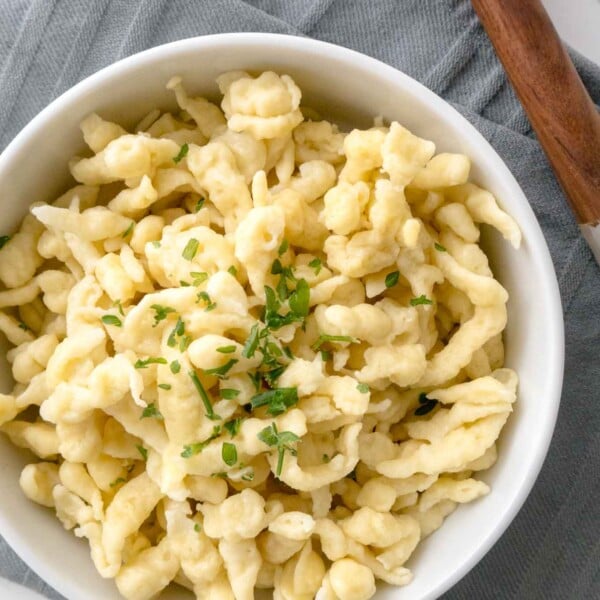
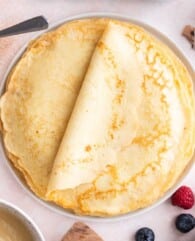
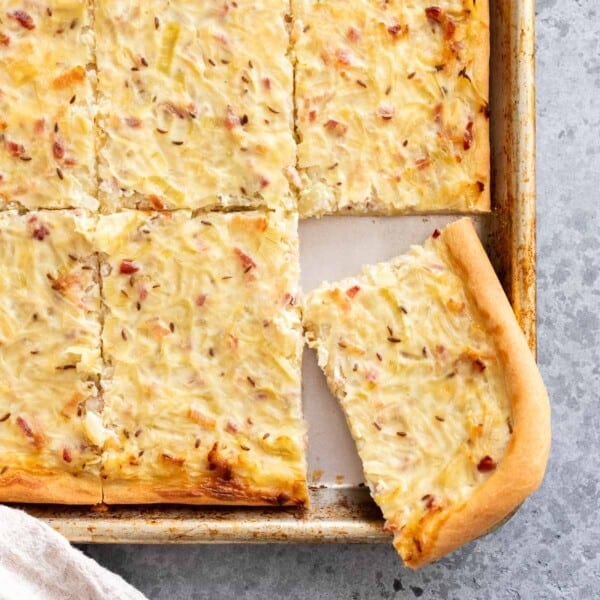
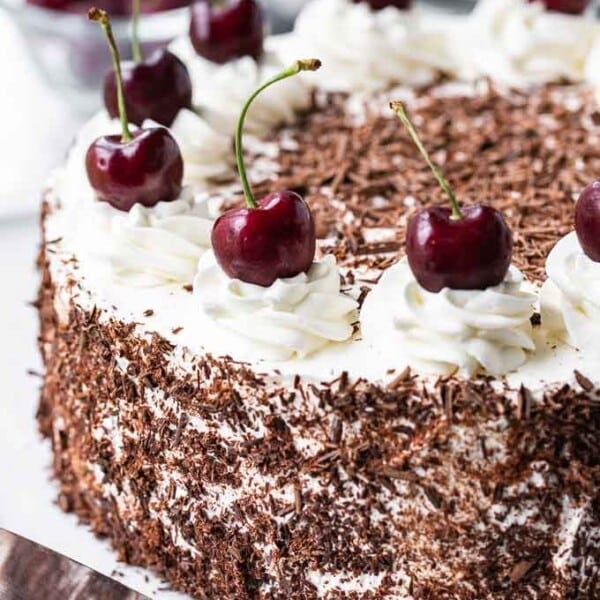
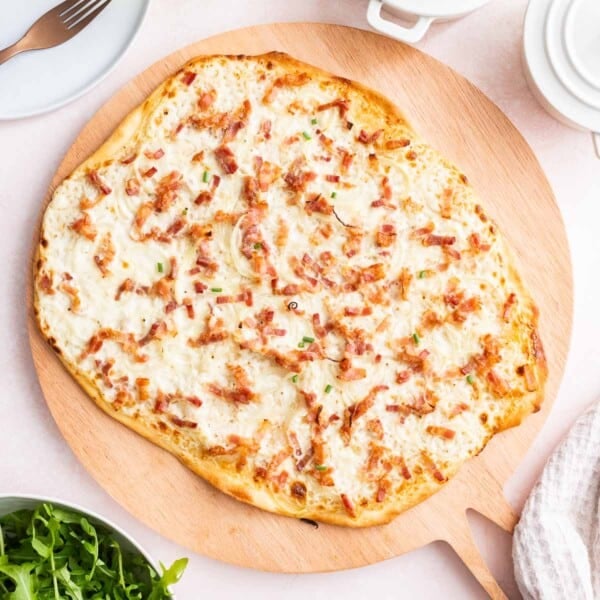
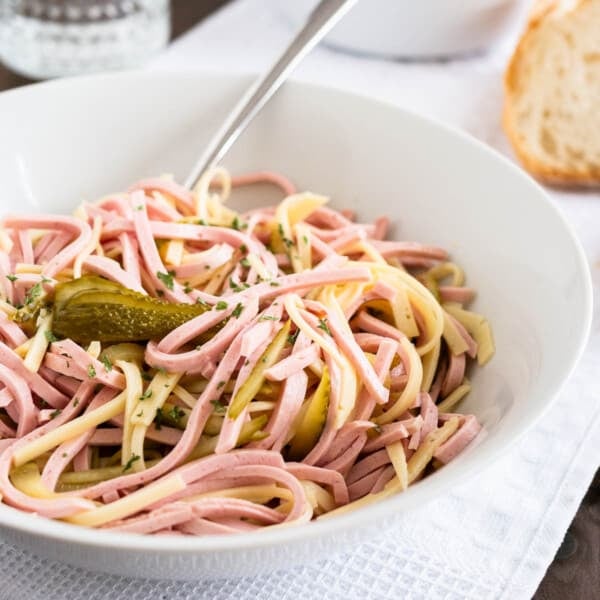






Danke für das Rezept. Thanks so much, the 🥞came out delicious. I added apple pieces and I used whole wheat flour. Greetings from Texas ❤️
Perfekt, feels like home and childhood. Best recipe and description I found so far. Thank you so much
My German mother used to make these as a special treat for dinner. She added about a half teaspoon of onion powder to it and it’s really much better with this! Without that they taste a bit flat. She did not add sparkling water though.
Interesting! I have never heard of anyone adding onion powder before.